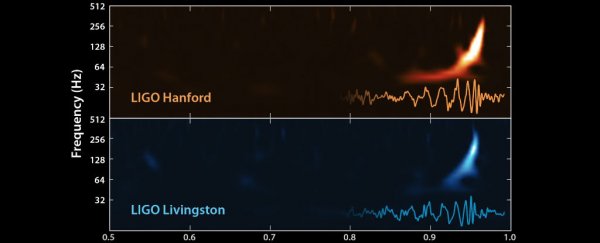The faint, flickering distortions of space-time we call gravitational waves are tricky to detect, and we've only managed to do so in recent years. But now scientists have calculated that these waves may leave more persistent traces of their passing - traces we may also be able to detect.
Such traces are called 'persistent gravitational wave observables', and in a new paper, an international team of researchers has refined the mathematical framework for defining them. In the process, they give three examples of what these observables could be.
Here's the quick lowdown on gravitational waves: When two massive objects such as neutron stars or black holes collide, they send shockwaves through the Universe, rippling the very fabric of space-time itself. This effect was predicted by Einstein in his theory of general relativity in 1916, but it wasn't until 2015 that we finally had equipment sensitive enough to detect the ripples.
That equipment is an interferometer that shoots two or more laser beams down arms that are several kilometres in length. The wavelengths of these laser beams interfere to cancel each other out, so, normally, no light hits the instrument's photodetectors.
But when a gravitational wave hits, the warping of space-time causes these laser beams to oscillate, shrinking and stretching. This means that their interference pattern is disrupted, and they no longer cancel each other out - so the laser hits the photodetector. The pattern of the light that hits can tell scientists about the event that created the wave.
But that shrinking and stretching and warping of space-time, according to astrophysicist Éanna Flanagan of Cornell University and colleagues, could be having a much longer-lasting effect.
As the ripples in space-time propagate, they can change the velocity, acceleration, trajectories and relative positions of objects and particles in their way - and these features don't immediately return to normal afterwards, making them potentially observable.
Particles, for instance, disturbed by a burst of gravitational waves, could show changes. In their new framework, the research team mathematically detailed changes that could occur in the rotation rate of a spinning particle, as well as its acceleration and velocity.
Another of these persistent gravitational wave observables involves a similar effect to time dilation, whereby a strong gravitational field slows time.
Because gravitational waves warp both space and time, two extremely precise and synchronised clocks in different locations, such as atomic clocks, could be affected by gravitational waves, showing different times after the waves have passed.
Finally, the gravitational waves could actually permanently shift the relative positions in the mirrors of a gravitational wave interferometer - not by much, but enough to be detectable.
Between its first detection in 2015 and last year, the LIGO-Virgo gravitational wave collaboration detected a handful of events before LIGO was taken offline for upgrades.
At the moment, there are not enough detections in the bank for a meaningful statistical database to test these observables.
But LIGO-Virgo was switched back on on 1 April, and since then has been detecting at least one gravitational wave event per week.
The field of gravitational wave astronomy is heating up, space scientists are itching to test new mathematical calculations and frameworks, and it won't be long before we're positively swimming in data.
This is just such an incredibly exciting time for space science, it really is.
The research has been published in Physical Review D.
